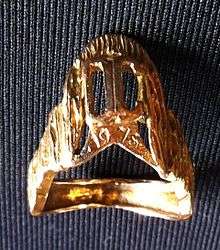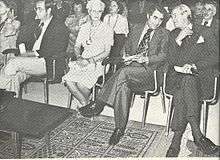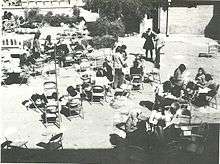Damavand College

Damavand College (in Persian: مدرسه عالی دماوند Madreseh-ye Ālī-ye Damāvand; later, دانشکده دماوند Dāneshkadeh-ye Damāvand) was a private institution of higher learning for women and in 1974 it became a public college, offering a four-year intercultural program in the liberal arts from 1968 to 1979 with the supervision of the Ministry of Higher Education of Iran in Tehran. It was a Missionary American institute and the first class was consisting of 62 seniors graduated in 1972 while in 1978 it was increased to 162 graduates.
In 1977-78, the college had over 800 Iranian and international students. According to Dr. Forough Jahanbakhsh, a graduate of 1980, it was one of the last educational centers that closed down preceding the Feb. 1979 Islamic Iranian Revolution. She thinks, it was after the Cultural Revolution that Damavand was amalgamated into what is now Allameh Tabatabai University. The collection of the books are now available at Central Library and the Documentation Center of Allameh Tabatabai University.[1] All classes were taught in English from the Freshman year on, except those on Iranian culture.[2]
Origin of the title
Damavand College takes its name from the beautiful Mount Damavand which rises out of the Alborz Range north of the city of Tehran. [3]
History
By 1978, Damavand College had a heritage of more than a century of service rendered by the American Presbyterian Mission in Tehran. Sage College, Alborz College, and Iran Bethel School which was established in 1874 were institutions founded under the auspices of this mission. Many graduates of Iran Bethel including, Iran Teymourtash, daughter of Reza Shah’s powerful court Minister; Molouk Khanoum Jalali, daughter of an Isfahani governor; Mehrtaj Rakhshan, educationalist and daughter of Agha Emam al Hokama; Satareh Farma Farmaian, founder of the professional field of social welfare in Iran and daughter of Qajar Prince Abdol Hossain Mirza Farman Farma; and Parvin E'tesami, a celebrated poet and daughter of Journalist and publisher Yusof E’tesami; are among some of Iran Bethel School’s graduates. Miss Jane Doolittle served for many years as the Principal of Iran Bethel School for Girls which was the immediate forerunner of Damavand College.
Presidents
From 1968 to 1979, Damavand College was served by three presidents, and Mary C. Thompson was the academic Dean all through the years. Under the leadership of Dr. Frances M. Gray (1910-2001), Damavand College was established in 1968 and that same year was accredited. From the time of the founding of the College, Gray continued as President until her retirement in June 1975.
Professor D. Ray Heisey (1932–2011), was the second president. He began his leadership in the fall of 1975. Heisey continued as president until 1978 to return to his position as professor of Rhetoric and Communication at the Kent State University in Ohio.
Dr. Carolyn Spatta, a cultural Geographer was the third and the last president of Damavand College that was taken over by the Iranian Government in 1979 when the Islamic Revolution replaced the Pahlavi Dynasty. In 1995 with Susan Christine Seymour, she wrote Asian College Women's Aspirations: A Comparative Study of the Effects of Maternal employment in which Damavand College has been named as one of the nine colleges that joined Asian Women Institutes in 1971 and in 1975 the organization to share its concern about women’s higher education in Asia.
Professor Mehdi Mohaghegh became the president of the college after the victory of the Revolution in February 1979. He was from Tehran University and one of the Professors of Persian Literature in the college. His presidency was short as with the formation of the Cultural Revolution in 1980, Damavand was amalgamated into what is now Allameh Tabatabai University and its existence came to an end.
Asian Women Institute
In 1975, nine colleges of the Asian Women's Institute including Damavand college that had been founded as Christian Colleges, joined together to share their concerns about women’s higher education in Asia. Earlier than that in 1971 representatives of those colleges agreed to plan for a joint organization. They are all still active with the same goals except for Damavand College that was closed in 1979 prior to the Islamic Revolution of Iran.
Academic program
The college offered a four-year intercultural program in the liberal arts leading to the Bachelor of Arts and Master of Arts degrees.
The curriculum was structured to include:
- A major in English literature, one in the Comparative History of Cultures (emphasis upon Persian and Western cross-cultural studies), and one in the Social Sciences.
- Minors in World Literature, Theater Arts, Anthropology/Sociology, Psychology, History of Culture, Administration, Women’s Studies, and Persian Culture were offered.
Gallery
 Class Ring 1975
Class Ring 1975 Jane Doolittle In a meeting in Iran Bethel School
Jane Doolittle In a meeting in Iran Bethel School Frances M. Gray in front of Damavand College building - 1975
Frances M. Gray in front of Damavand College building - 1975 President D. Ray Heisey and the unfinished college building - 1975
President D. Ray Heisey and the unfinished college building - 1975 Mary C. Thompson- the Academic Dean of Damavand College, 1969-1978
Mary C. Thompson- the Academic Dean of Damavand College, 1969-1978 The unfinished library - 1975
The unfinished library - 1975 The courtyard - 1977
The courtyard - 1977 Old Campus of Damavand College - 1974
Old Campus of Damavand College - 1974 The former Iran Bethel School courtyard in 1974
The former Iran Bethel School courtyard in 1974
References
- ↑ http://atu.ac.ir/en/contents/research/cldc/Central.Library.and.Documentation.Center.html
- ↑ Damavand College year Books
- ↑ Damavand College Catalog 1974-1975
External links
| Wikimedia Commons has media related to Damavand College. |
